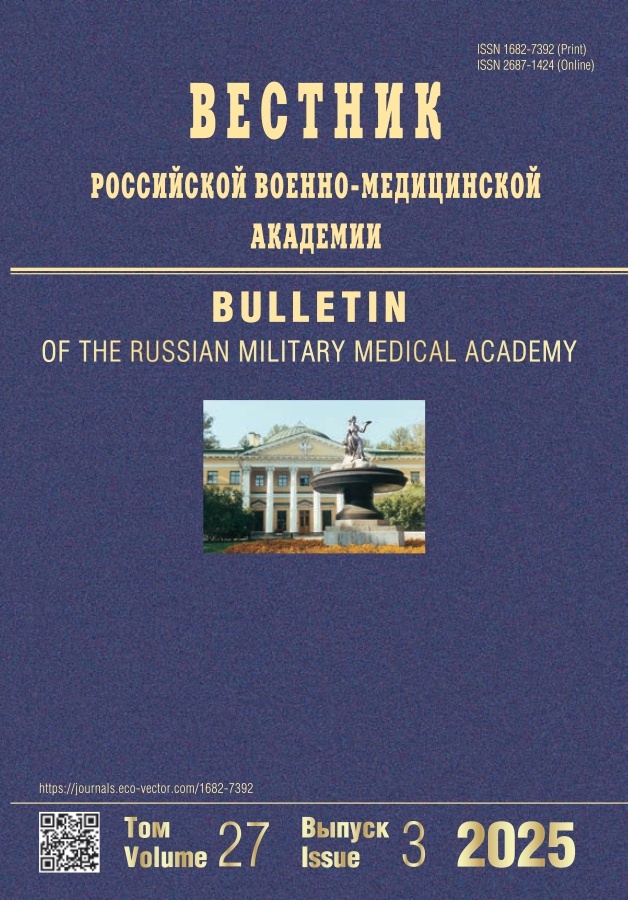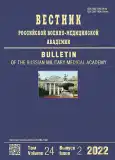Analysis of the incidence of COVID-19 in organized military collectives of various types
- Authors: Gorenchuk A.N.1, Zhogolev S.D.2, Kuzin A.A.2, Kulikov P.V.2, Zhogolev K.D.2, Ustinov A.E.1, Kuznetsova R.Y.2
-
Affiliations:
- 985 Center for State Sanitary and Epidemiological Supervision of the Ministry of Defense of Russia
- Military Medical Academy of S.M. Kirov
- Issue: Vol 24, No 2 (2022)
- Pages: 289-297
- Section: Original Study Article
- URL: https://journals.rcsi.science/1682-7392/article/view/106464
- DOI: https://doi.org/10.17816/brmma106464
- ID: 106464
Cite item
Abstract
Against the background of the global spread of the new SARS-CoV-2 coronavirus, the prevention of infections with airborne mechanisms of transmission has become a priority in the Armed Forces. The development of effective COVID-19 prevention measures requires consideration of the peculiarities of military service and everyday life due to the inability of organized military collectives to comply with the requirements of the lockdown regime introduced at the peak of morbidity by the civilian health system. The patterns of incidence of COVID-19 in military personnel of the Western Military District in organized military collectives were studied in relation to the conditions of training and combat activities and the characteristics of military service. It was found that the dynamics of the incidence of COVID-19 among military personnel of the Western Military District in 2020–2021 exhibited a wave-like character and included four epidemic rises that coincided with epidemic waves among the civilian population. At the same time, from April to December 2020, the morbidity rate in military personnel was significantly higher than that in the general population, and from January to December 2021 against the background of mass vaccination of military personnel against COVID-19, the incidence rate in military personnel decreased by 50% relative to that in the general population. The effectiveness of anti-epidemic measures has increased significantly in recent months. The average number of patients in the epidemic outbreak decreased by 46.3%, the average duration of the outbreak decreased by 12.4%, and the proportion of group morbidity in the structure of the overall incidence of COVID-19 decreased by 19.8%. It is shown that the incidence of COVID-19 in various types of military collectives depends on the conditions of military service and the specifics of daily activities. The highest epidemiological significance of COVID-19 was detected in military units of constant readiness, as well as in medical and military educational organizations.
Full Text
##article.viewOnOriginalSite##About the authors
Alexey N. Gorenchuk
985 Center for State Sanitary and Epidemiological Supervision of the Ministry of Defense of Russia
Author for correspondence.
Email: gera_82@mail.ru
SPIN-code: 7755-3261
Major of the Medical Service
Russian Federation, Saint PetersburgSergey D. Zhogolev
Military Medical Academy of S.M. Kirov
Email: SZhogolev@rambler.ru
SPIN-code: 7667-5729
Doctor of Medical Sciences, Professor
Russian Federation, Saint PetersburgAlexander A. Kuzin
Military Medical Academy of S.M. Kirov
Email: paster-spb@mail.ru
SPIN-code: 6220-1218
Doctor of Medical Sciences, Associate Professor
Russian Federation, Saint PetersburgPavel V. Kulikov
Military Medical Academy of S.M. Kirov
Email: kpvsel@mail.ru
SPIN-code: 7920-4582
Candidate of Medical Sciences
Russian Federation, Saint PetersburgKonstantin D. Zhogolev
Military Medical Academy of S.M. Kirov
Email: kjogolev@rambler.ru
SPIN-code: 8445-2245
Doctor of Medical Sciences, Associate Professor
Russian Federation, Saint PetersburgAleksey E. Ustinov
985 Center for State Sanitary and Epidemiological Supervision of the Ministry of Defense of Russia
Email: 3312600@bk.ru
SPIN-code: 9097-9557
Сhief Of Microbiological Section
Russian Federation, Saint PetersburgRegina Yu. Kuznetsova
Military Medical Academy of S.M. Kirov
Email: regina0497@yandex.ru
SPIN-code: 9331-3540
Department Officer
Russian Federation, Saint PetersburgReferences
- Scheuller SH, Park J, Lott L, et al. Comparison of clinical features in a population of basic military trainees versus the general department of defense beneficiary population presenting with influenza. Military Medicine. 2017;182(9-10):1917–1921. doi: 10.7205/milmed-d-16-00363
- Tavakoli A, Karbalaie NMH, Bokharaei-Salim F, et al. The molecular epidemiology of respiratory viruses in military trainees in Iran. Med J Islam Repub Iran. 2019;33:40. doi: 10.34171/mjiri.33.40
- Webber BJ, Flower AM, Pathak SR, et al. Physical and mental health of us air force military training instructors. Military Medicine. 2019;184(5-6):248–254. doi: 10.1093/milmed/usy418
- Kalinina SB. Rossiiskaya armiya v usloviyakh pandemii. Zametki uchenogo. 2021;(3-1):170–174. (In Russ.).
- Kuzin AA, Lantsov EV, Yumanov AP, et al. View of Military Epidemiologists on the Problem of Global Spread of a New Coronavirus Infection. Epidemiology and Vaccinal Prevention. 2021;20(3):53–59. (In Russ.) doi: 10.31631/2073-3046-2021-20-3-53-59
- The Parisian Military Anti–COVID-19 Group. Small but nimble: measures taken to face the COVID-19 pandemic in small French military hospitals. Am J Manag Care. 2021;27(4):135–136. doi: 10.37765/ajmc.2021.88623
- Pishchugin DYu, Knyazev MYu, Silenko YuA, Marchenko EA. Opyt raboty spetsialistov 637 TSGSEHN v ochagakh COVID-19. Proceedings of the Online congress with international participation: «Molekulyarnaya diagnostika i biobezopasnost’-2021. COVID-19: ehpidemiologiya, diagnostika, profilaktika». Moscow, 2021. P. 37. (In Russ.).
- Khanina EE. Treatment and prevention of new coronavirus infection (COVID-19). Evraziiskoe Nauchnoe Ob’edinenie. 2021; (6-3):198–204. (In Russ.). doi: 10.5281/zenodo.5090182
- Hall A, Qureshi I, Glaser J, et al. Cost and benefit of military quarantine policiesю. Prev Med. 2021;143:106371. doi: 10.1016/j.ypmed.2020.106371
- Wentz LM, Ward MD, Potter C, et al. Increased Risk of Upper Respiratory Infection in Military Recruits Who Report Sleeping Less Than 6 h per night. Military Medicine. 2018;183(11-12):699–704. doi: 10.1093/milmed/usy090
- Agadzhanyan AA, Baziyants LR, Bezbabicheva TS. Povtornye ehpizody COVID-19: variatsii i prichiny. Proceedings of the XXXVIII International research competition «Luchshaya studencheskaya stat’ya 2021». Penza, 2021. P. 180–182. (In Russ.).
- Popova AY, Smirnov VS, Ezhlova EB, et al. Herd immunity to SARS-CoV-2 in the Novosibirsk Region population amid the COVID-19 pandemic. Problems of Virology. 2021;66(4):299–309. (In Russ.). doi: 10.36233/0507-4088-54
- Glantz SA. Primer of biostatistics. 4-th edition. Buzikashvili NE, Samoilov DV, editors. Translate by YuA Danilova. Moscow: Praktika, 1998. 459 p. (In Russ.).
- Pokrovskii VI, Briko NI, editors. Obshchaya ehpidemiologiya s osnovami dokazatel’noi meditsiny: rukovodstvo k prakticheskim zanyatiyam. Moscow: GEHOTAR-Media, 2018. 496 p. (In Russ.).
- Kryukov EV, Trishkin DV, Ivanov AM, et al. Comparative Cohort Epidemiological Study of Collective Immunity against New Coronavirus Infection among Different Groups of Military Personnel. Annals of the Russian Academy of Medical Sciences. 2021;76(6): 661–668. (In Russ.). doi: 10.15690/vramn1583
- Artebyakin SV, Lantsov EV, Kuzin AA. Aktual’nost’ i metodicheskii podkhod k izucheniyu kollektivnogo immuniteta k novoi koronavirusnoi infektsii v organizovannykh kollektivakh. Proceedings of the online congress with international participation: «Molekulyarnaya diagnostika i biobezopasnost’-2021. COVID-19: ehpidemiologiya, diagnostika, profilaktika». Moscow, 2021. P. 18. (In Russ.).
Supplementary files













